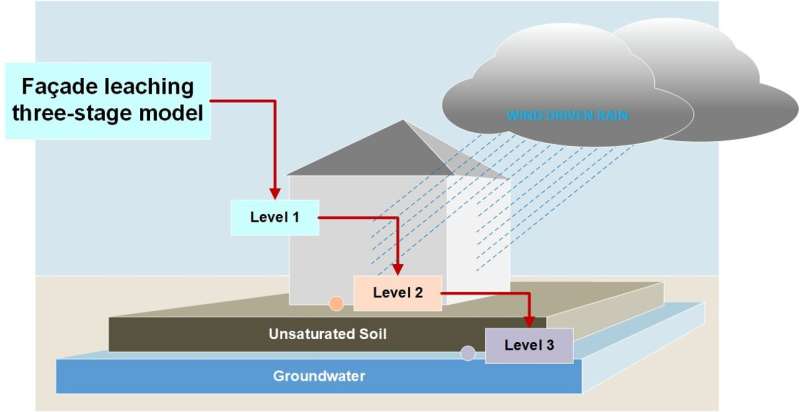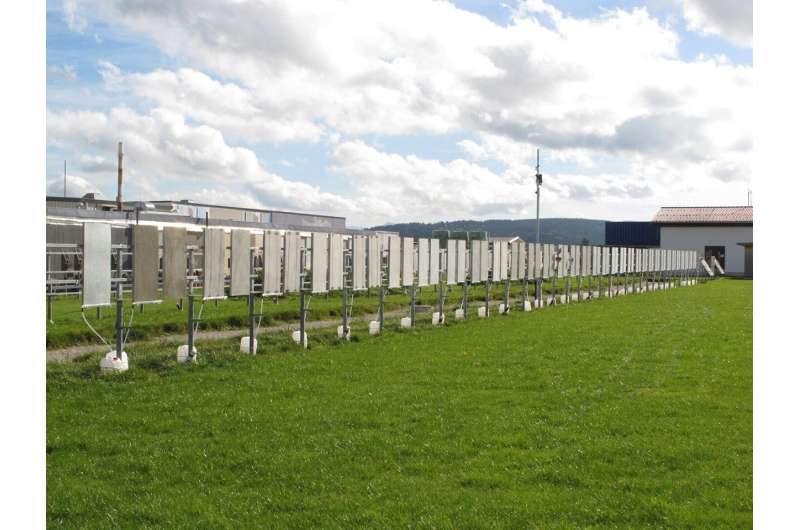This article has been reviewed according to Science X's editorial process and policies. Editors have highlighted the following attributes while ensuring the content's credibility:
fact-checked
trusted source
proofread
Mathematical model predicts what is leached out of building facades by rain

The plaster and mortar used in facades often contain heavy metals and biocides that leach out and infiltrate into the soil when it rains. The Fraunhofer Institute for Building Physics IBP has created a model that combines measurements of the substances that leach out with regional meteorological data.
This creates a precise forecast that can be used at the planning stage to determine the type and amount of substances that could be released from facade materials when it rains. This complex project was a collaborative effort alongside universities and numerous partners from industry.
Materials used for facades, like plaster and mortar, are complex formulations. Generally, mineral formulations are composed of mostly sand and binding agents such as cement, gypsum or lime. State-of-the-art paste-like plasters are often enriched with biocides in order to inhibit the growth of fungi and algae on the facade. When the sun is shining, this is not an issue. However, if it rains and the wind pushes the rainwater against the wall of the building, it could become a problem.
If this happens, the ingredients used in facade plaster are washed off by the rain and, along with the runoff, drain into the sewage system, the soil and—in the worst-case scenario—groundwater. Researchers from Fraunhofer IBP have developed a mathematical model that can precisely predict which substances in facade plaster will leach out in the rain.
Dr. Pablo Alberto Vega Garcia, expert in ecological chemistry and microbiology at the Environment, Hygiene and Sensor Technology department at Fraunhofer IBP, says, "The environmental risks caused by rainwater runoff from facades covered with plaster and mortar have aroused increased interest in recent years. Mineral plaster contains inorganic heavy metals like chromium, vanadium and lead, while paste-like plasters contain biocides.
"Our thermodynamic model provides information on the concentrations of substances in rainwater runoff. The model is very detailed and informative, as we have incorporated regional weather data and the recipe of each building material."
For the first time, building contractors and architectural firms can assess the environmental compatibility of the materials they are considering for a facade right from the planning stage. Plaster and mortar manufacturers can use the model to develop highly environmentally friendly products.
Fraunhofer IBP has been working with a variety of partners on this project—these include the Technical University of Munich, RWTH Aachen University and the German Association for Insulation Systems, Plaster and Mortar (VDPM) as well as partners from industry and facade building material manufacturers.

Field trials on facade plaster
For more than a decade, Fraunhofer IBP experts at the Holzkirchen site have conducted field trials to research the chemical, physical and kinetic processes that occur when harmful substances undergo leaching. To do so, they have exposed samples of various formulations of plaster and mortar to the elements for 18 months at a time.
After each rainfall, the water that had flowed off the samples underwent laboratory testing for relevant substances and the concentration of these was determined. Added to this were meteorological data such as the amount and duration of rain, wind strength and direction, and temperature. Solar radiation was also taken into account. Additionally, laboratory tests were conducted on leaching under specific conditions.
This has resulted in an extensive database with data sets on the concentration of the leached substances, weather conditions and the constituents of the samples tested. Material recipes on the constituents were supplied by the manufacturers.
"We have used this data to develop a three-stage thermodynamic model," explains Vega Garcia. "At the first stage, we measure how much rainwater is running off the facade. This is vital for getting accurate results, as not all of the water runs off the facade as a film during heavy rain—some bounces off the wall and some is absorbed by the facade. Weather data and material properties are also taken into account here.
"At stage two, the concentrations of heavy metals in the water that runs off each sample are measured and quantified. At this juncture, vanadium, chromium and lead were found to be relevant substances as they appeared in high concentrations. Finally, this is followed in stage three by a Groundwater Risk Assessment to estimate the concentration at a specific point of compliance."
Manufacturers can thereby create a model for each of their facade plasters during the planning stage and use this to assess the environmental properties of each product.
The model designed by Fraunhofer researchers assesses environmental conformity at the limits set by the German Working Group on water issues of the Federal States and the Federal Government (LAWA). If the concentrations of harmful substances determined are below the de minimis threshold, the concentration of substances present in the seepage is considered to be safe.
Eco-friendly materials
Manufacturers of facade building materials can rely on the three-stage model from Fraunhofer IBP when developing new products, as it allows them to adapt their formulae in such a way that the levels of substances expected to be released due to rainwater runoff for a specific region and its typical weather remain below the de minimis threshold.
"This is vitally important for facades in urban areas as well as in regions that frequently experience heavy rain, for example," says Vega Garcia. Authorities can use the model to define specific areas in which facade building materials can be used, for instance.
As a next step, Fraunhofer researchers want to refine the model to calculate the transformation products that arise from biocides as a result of environmental influences and to transfer the model for use with other materials. For example, it has been known for quite some time that root penetration inhibitors used to protect roofing membranes from root penetration in flat roofs with bituminous sheeting leach out and can filter into the environment through water runoff.




















